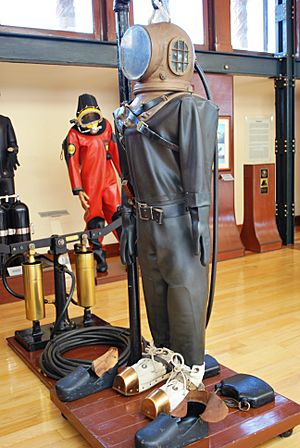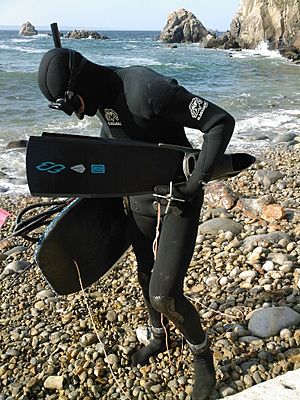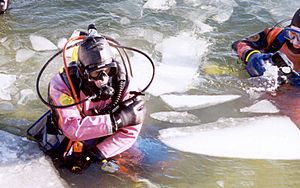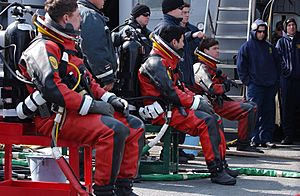Diving suit facts for kids
A diving suit is special clothing worn by divers when they explore underwater in oceans, lakes, and rivers. These suits help keep the diver warm by insulating them from the cold water. There are different kinds of diving suits, like wetsuits and dry suits.
Contents
History of Diving Suits
The first ideas for diving suits appeared in the early 1700s. Two English inventors created the first suits that could handle water pressure around 1710.
John Lethbridge built a suit that completely enclosed the diver. It looked like a strong, air-filled barrel with a glass window and two waterproof sleeves. This design allowed divers to move more freely and do useful work underwater, like finding sunken treasures.
Lethbridge tested his invention in a special pond in his garden. He then used it to dive on many shipwrecks, including English warships and Spanish galleons. He became very rich from the treasures he found. One famous recovery was from the Dutch ship Slot ter Hooge, which sank near Madeira with over three tons of silver.
Around the same time, Andrew Becker made a diving suit covered in leather with a helmet that had a window. Becker's suit used tubes for breathing in and out. He showed off his suit in the River Thames in London, staying underwater for an hour.
A German-born British engineer named Augustus Siebe created the standard diving dress in the 1830s. He improved on earlier designs by adding a helmet to a full-length, waterproof canvas diving suit. Later suits were made from waterproofed canvas invented by Charles Mackintosh. For most of the 1900s, these suits were made from a sheet of rubber between layers of strong fabric.
During World War II, Italian frogmen used dry suits made of latex rubber. These suits were very important for their missions. The company Pirelli made them and patented them in 1951.
Ambient Pressure Suits
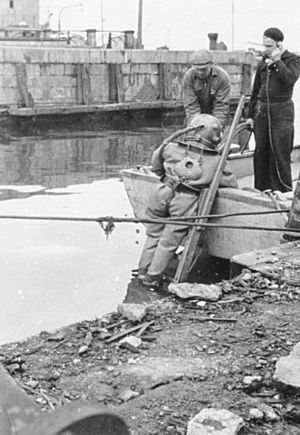
Ambient pressure suits protect divers from the cold. They also offer some protection from sharp objects and dangerous underwater creatures. However, these suits do not protect divers from the actual pressure of the water. This means they don't prevent problems like barotrauma (injuries from pressure changes) or decompression sickness.
There are five main types of ambient pressure diving suits:
- Dive skins
- Wetsuits (and semi-dry suits)
- Hot-water suits
- Dry suits
Besides hot-water suits, these suits are also used for other water sports like surfing, sailing, powerboating, windsurfing, kite surfing, waterskiing, caving, and swimming.
Most diving suits add some buoyancy (they make you float). Divers often wear a special weight belt to help them sink and stay underwater.
Dive Skins
Dive skins are used in warm water, usually above 25°C (77°F). They are made from spandex or Lycra fabric. They offer very little warmth but are great for protecting your skin from jellyfish stings, scrapes, and sunburn. They are sometimes called 'Stinger Suits'. Some divers wear a dive skin under a wetsuit. This makes it easier to put on the wetsuit and can be more comfortable for people with sensitive skin.
The "Dive Skin" was first invented in Queensland, Australia, to protect divers from the dangerous "Box" jellyfish (Chironex fleckeri). In 1978, Tony Farmer, a swimsuit designer, created the first dive skin as we know it today.
Wetsuits
Wetsuits are simple and affordable suits made from a material called neoprene. They are typically used in water temperatures between 10°C and 25°C (50°F and 77°F). The foamed neoprene in the suit helps keep the wearer warm.
Even though water can enter a wetsuit, a well-fitting suit prevents too much heat loss. This is because the small amount of water inside the suit gets warmed by your body. This warm water then stays trapped, preventing cold water from constantly flowing in and out (a process called "flushing").
A proper fit is very important for warmth. If a suit is too loose, a lot of cold water will flow over your skin, making you lose body heat. If a suit is too tight, it can be uncomfortable and even dangerous by cutting off blood flow, especially around the neck. Because of this, many divers choose to have wetsuits made just for them, rather than buying standard sizes.
Wetsuits have limits in how well they keep you warm. First, you are still exposed to some water. Second, the suit gets squeezed by the water pressure as you go deeper, which makes it less effective. Third, the neoprene can only be so thick before it becomes too hard to put on and wear. The thickest wetsuits are usually 10 mm thick. Other common thicknesses are 7 mm, 5 mm, 3 mm, and 1 mm. A 1 mm suit offers very little warmth and is often considered more like a dive skin. Wetsuits can be made with different thicknesses of neoprene in different areas to provide the best warmth. You can also wear multiple wetsuits for more warmth.
Semi-dry Suits
Semi-dry suits are like very thick wetsuits with special, almost watertight seals at the wrists, neck, and ankles, and a waterproof zipper. They are usually used in water temperatures between 10°C and 20°C (50°F and 68°F). The seals stop most water from getting in or out. Even though you get wet in a semi-dry suit, the small amount of water that enters quickly warms up and stays trapped, keeping you warm.
The trapped water itself doesn't add to the suit's insulation. However, semi-dry suits are cheaper and simpler than dry suits. They are made from thick neoprene, which provides good warmth. But like wetsuits, they lose some warmth and buoyancy as you go deeper because the gas bubbles in the neoprene get squeezed. Semi-dry suits usually don't include hoods, boots, or gloves, so these are worn separately for extra warmth.
Hot Water Suits
Hot water suits are used by commercial divers who work in very cold water, often supplied from the surface. A hose from the surface carries hot water down to the suit. The diver can control the flow of water to stay comfortable. Tubes inside the suit spread the hot water to the arms, legs, chest, and back. Special boots, gloves, and a hood are also worn.
These suits are made of foamed neoprene, similar to wetsuits, but they are designed to be looser. This allows the hot water to flow freely through the suit and out through the open wrists and ankles, constantly replacing it with fresh hot water from the surface.
Hot water suits are often used for extremely deep dives where divers breathe gas mixes that contain helium. Helium takes away body heat much faster than air, so divers can get very cold quickly. In these conditions, a hot water suit is essential for survival. Just like divers need a backup air supply, a backup water heater is also crucial. If the heater fails in very cold water, a diver could die in minutes.
The hot water in the suit creates a warm barrier, but the temperature must be carefully controlled. If it's too cold (below 32°C or 90°F), the diver can get hypothermia. If it's too hot (above 45°C or 113°F), the diver can get burned. The diver might not notice small changes in temperature. The suit is loose, so it holds a lot of water (13 to 22 liters), which can make swimming harder. When controlled correctly, hot water suits are safe and effective, giving the diver good control over their warmth.
Dry Suits
Dry suits are typically used in very cold water, from -2°C to 15°C (28°F to 59°F). Water is kept out of the suit by special seals at the neck and wrists, and a waterproof zipper for getting in and out. The suit keeps the diver warm in two main ways:
- By trapping a layer of air in an undersuit between your body and the suit's outer shell. This works like warm clothes you wear on land.
- By using a watertight neoprene suit shell, which is naturally insulating, similar to a wetsuit. You can also wear extra warm clothes underneath this type.
Both fabric and neoprene dry suits have their pros and cons. A fabric dry suit is more flexible for different water temperatures because you can wear different layers of clothing underneath. However, they can be bulky, making it harder to swim. Also, if a fabric dry suit leaks, it loses almost all its warmth. Neoprene dry suits are more streamlined, like wetsuits. They might not allow as many layers underneath, making them less flexible for changing temperatures. But if a neoprene dry suit leaks, it still acts like a wetsuit and provides some warmth.
Special dry suits, usually made of strong rubberized fabric, are worn by commercial divers who work in dirty or dangerous places, like sewage or with harmful chemicals. These "hazmat" dry suits have built-in boots and are sealed to a diving helmet and dry gloves to keep the diver completely safe from the hazardous material.
"Constant volume" dry suits have a system that lets you add air to the suit. This prevents the suit from squeezing you as you go deeper and keeps the insulating clothes underneath from getting squashed. They also have valves to let excess air out as you go up.
For even more warmth, some dry suit users fill their suits with argon gas. Argon is an inert gas that insulates better than air. The argon is carried in a small tank separate from the diver's breathing gas. This is often done when the breathing gas contains helium, which is a very poor insulator.
Diving Suit Combinations
Sometimes, a "shortie" wetsuit (a shorter wetsuit) can be worn over a full wetsuit for extra warmth. Some companies call this a 'core warmer' when worn over another wetsuit. A "skin" (a thin suit) can also be worn under a wetsuit. This started with divers wearing body tights under their wetsuits for more warmth and to make it easier to put on and take off the wetsuit. A "skin" can also be used as a thin undersuit beneath a dry suit in warmer conditions where a thick undersuit isn't needed.
Atmospheric Diving Suits
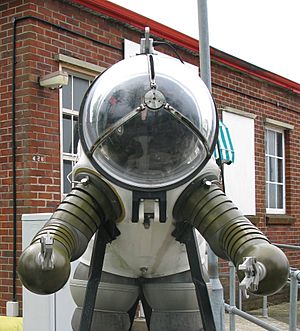
An atmospheric diving suit (ADS) is like a small, one-person underwater robot that looks like a suit of armor. It has special joints that allow the diver to move while keeping the inside pressure the same as on the surface.
These suits can be used for very deep dives for long periods without the need for decompression stops. They also remove most of the dangers linked to deep diving. Divers don't even need to be skilled swimmers to use them. However, moving around and using your hands can be difficult because of the suit's mechanical parts.
See also
 In Spanish: Traje de buceo para niños
In Spanish: Traje de buceo para niños




